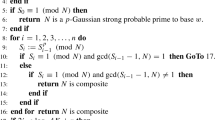Abstract
From 1876 to 1880 Lucas developed his theory of the functions v n and u n which now bear his name. Today these functions find use in primality testing and integer factorization, among other computational techniques. The functions v n and u n can be expressed in terms of the nth powers of the zeroes of a quadratic polynomial, and throughout his writings Lucas speculated about the possible extension of these functions to those which could be expressed in terms of the nth powers of the zeroes of a cubic polynomial or of a quartic polynomial. Indeed, at the end of his life he stated that by searching for the addition formulas of the numerical functions which originate from recurrence sequences of the third or fourth degree and by studying in a general way the laws of the residues of these functions for prime moduli, we would arrive at important new properties of prime numbers. We only have scattered hints concerning what functions Lucas had in mind because he provided so little information about them in his published and unpublished work. In this paper we discuss two pairs of functions that are easily expressed as certain combinations of the n th powers of the zeroes of a quartic polynomial and of a sextic polynomial, respectively. We also present several new results, which illustrate the striking similarity between these functions and those of Lucas. The methods that we use to obtain these results are for the most part elementary and would likely have been known to Lucas.
Access this chapter
Tax calculation will be finalised at checkout
Purchases are for personal use only
Similar content being viewed by others
Notes
- 1.
It seems that G is always 1, but we have not been able to prove this in general.
References
J.P. Bézivin, A. Pethö, A.J. van der Poorten, A full characterization of divisibility sequences. Am. J. Math. 112, 985–1001 (1990)
E.T. Bell, Analogies between the u n , v n of Lucas and elliptic functions. Bull. Am. Math. Soc. 29, 401–406 (1923)
M. Hall, Slowly increasing arithmetic series. J. Lond. Math. Soc. 8, 162–166 (1933)
M. Hall, Divisibility sequences of the third order. Am. J. Math. 58, 577–584 (1936)
D.H. Lehmer, Tests for primality by the converse of Fermat’s theorem. Bull. Am. Math. Soc. 33, 327–340 (1927)
É. Lucas, Note sur l’application des séries récurrentes à la recherche de la loi de distribution des nombres premiers. Comp. Rend. Acad. Sci. Paris 82, 165–167 (1876)
É. Lucas, Recherches sur plusiers ouvrages de Leonard de Pise et sur diverse questions d’arithmétique supérieure. Boll. Bibliogr. Storia Sci. Matemat. Fisiche 10, 129–193, 239–293 (1877)
É. Lucas, Sur la théorie des fonctions numériques simplement périodiques. Nouv. Corresp. Math. 3 369–376, 401–407 (1877); 4, 1–8, 33–40, 65–71, 97–102, 129–134, 225–228 (1878)
É. Lucas, Théorie des fonctions numériques simplement périodiques. Am. J. Math. 1, 184–240, 289–321 (1878)
É. Lucas, Notice sur les Titres et Travaux Scientifiques de M. Édouard Lucas (D. Jouaust, Paris, 1880)
É. Lucas, Théorie des Nombres (Gauthier-Villars, Paris, 1891)
É. Lucas, Questions proposées à la discussion des 1re et 2e sections, 1o Questions d’arithmétique supérieure. Assoc. Française l’Avancement Sci. Comp. Rend. Sessions 20, 149–151 (1891)
S. Müller, E. Roettger & H.C. Williams, A cubic extension of the Lucas functions. Ann. Sci. Math. Québec 33, 185–224 (2009)
A.D. Oosterhout, Characterization of divisibility sequences. Master’s Thesis, Utrecht University, June 2011
T.A. Pierce, The numerical factors of the arithmetic forms \(\prod _{i=1}^{n}(1 \pm \alpha _{i}^{m})\). Ann. Math. (2nd Ser.) 18, 53–64 (1916)
A. Pethö, Complete solutions to a family of quartic diophantine equations. Math. Comp. 57, 777–798 (1991)
A. Pethö, Egy negyedrendü rekurzív sorozatcsaládról. Acta Acad. Paed. Agriensis Sect. Math. 30, 115–122 (2003). MR2054721 (2005g:11018)
E. Roettger, A cubic extension of the Lucas functions. PhD Thesis, Univ. of Calgary, 2009. http://math.ucalgary.ca/~hwilliam/files/A Cubic Extensionof the Lucas Functions.pdf
N. Sloane, Online encyclopedia of integer sequences. http://oeis.org/wiki/
M. Ward, The law of apparition of primes in a Lucasian sequence. Trans. Am. Math. Soc. 44, 68–86 (1938)
M. Ward, The laws of apparition and repetition of primes in a cubic recurrence. Trans. Am. Math. Soc. 79, 72–90 (1955)
H.C. Williams, Édouard Lucas and Primality Testing. Canadian Mathematical Society Series of Monographs and Advanced Texts, vol 22 (Wiley, New York, 1998)
H.C. Williams, R.K. Guy, Some fourth order linear divisibility sequences. Int. J. Number Theory 7(5), 1255–1277 (2011)
Acknowledgements
H.C. Williams: Research supported in part by NSERC of Canada.
Author information
Authors and Affiliations
Corresponding author
Editor information
Editors and Affiliations
Additional information
Dedicated to the memory of Alfred J. van der Poorten (1942–2010)
Rights and permissions
Copyright information
© 2013 Springer Science+Business Media New York
About this paper
Cite this paper
Roettger, E.L., Williams, H.C., Guy, R.K. (2013). Some Extensions of the Lucas Functions. In: Borwein, J., Shparlinski, I., Zudilin, W. (eds) Number Theory and Related Fields. Springer Proceedings in Mathematics & Statistics, vol 43. Springer, New York, NY. https://doi.org/10.1007/978-1-4614-6642-0_15
Download citation
DOI: https://doi.org/10.1007/978-1-4614-6642-0_15
Published:
Publisher Name: Springer, New York, NY
Print ISBN: 978-1-4614-6641-3
Online ISBN: 978-1-4614-6642-0
eBook Packages: Mathematics and StatisticsMathematics and Statistics (R0)




